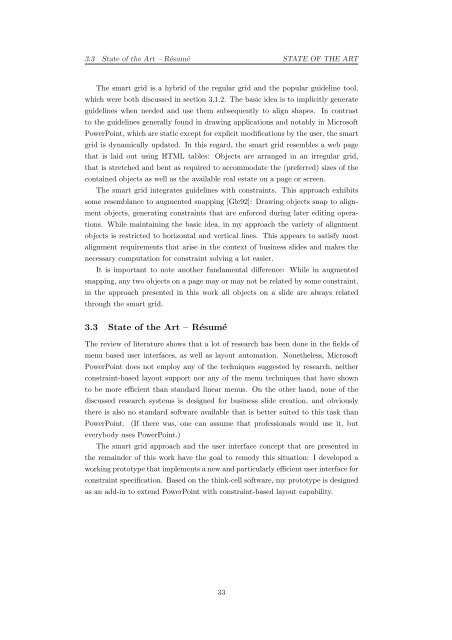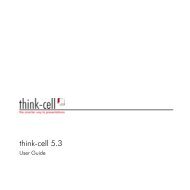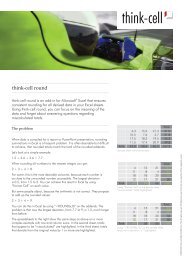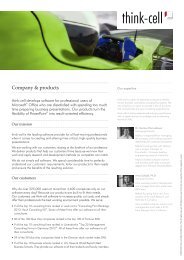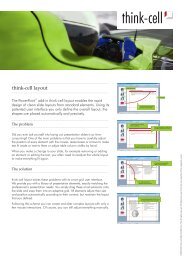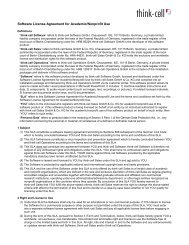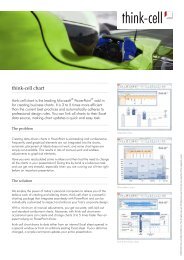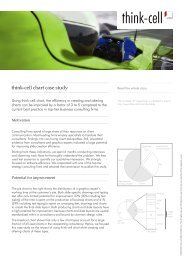think-cell technical report TC2003/01 A GUI-based Interaction ...
think-cell technical report TC2003/01 A GUI-based Interaction ...
think-cell technical report TC2003/01 A GUI-based Interaction ...
Create successful ePaper yourself
Turn your PDF publications into a flip-book with our unique Google optimized e-Paper software.
3.3 State of the Art – Résumé STATE OF THE ART<br />
The smart grid is a hybrid of the regular grid and the popular guideline tool,<br />
which were both discussed in section 3.1.2. The basic idea is to implicitly generate<br />
guidelines when needed and use them subsequently to align shapes. In contrast<br />
to the guidelines generally found in drawing applications and notably in Microsoft<br />
PowerPoint, which are static except for explicit modifications by the user, the smart<br />
grid is dynamically updated. In this regard, the smart grid resembles a web page<br />
that is laid out using HTML tables: Objects are arranged in an irregular grid,<br />
that is stretched and bent as required to accommodate the (preferred) sizes of the<br />
contained objects as well as the available real estate on a page or screen.<br />
The smart grid integrates guidelines with constraints. This approach exhibits<br />
some resemblance to augmented snapping [Gle92]: Drawing objects snap to align-<br />
ment objects, generating constraints that are enforced during later editing opera-<br />
tions. While maintaining the basic idea, in my approach the variety of alignment<br />
objects is restricted to horizontal and vertical lines. This appears to satisfy most<br />
alignment requirements that arise in the context of business slides and makes the<br />
necessary computation for constraint solving a lot easier.<br />
It is important to note another fundamental difference: While in augmented<br />
snapping, any two objects on a page may or may not be related by some constraint,<br />
in the approach presented in this work all objects on a slide are always related<br />
through the smart grid.<br />
3.3 State of the Art – Résumé<br />
The review of literature shows that a lot of research has been done in the fields of<br />
menu <strong>based</strong> user interfaces, as well as layout automation. Nonetheless, Microsoft<br />
PowerPoint does not employ any of the techniques suggested by research, neither<br />
constraint-<strong>based</strong> layout support nor any of the menu techniques that have shown<br />
to be more efficient than standard linear menus. On the other hand, none of the<br />
discussed research systems is designed for business slide creation, and obviously<br />
there is also no standard software available that is better suited to this task than<br />
PowerPoint. (If there was, one can assume that professionals would use it, but<br />
everybody uses PowerPoint.)<br />
The smart grid approach and the user interface concept that are presented in<br />
the remainder of this work have the goal to remedy this situation: I developed a<br />
working prototype that implements a new and particularly efficient user interface for<br />
constraint specification. Based on the <strong>think</strong>-<strong>cell</strong> software, my prototype is designed<br />
as an add-in to extend PowerPoint with constraint-<strong>based</strong> layout capability.<br />
33


